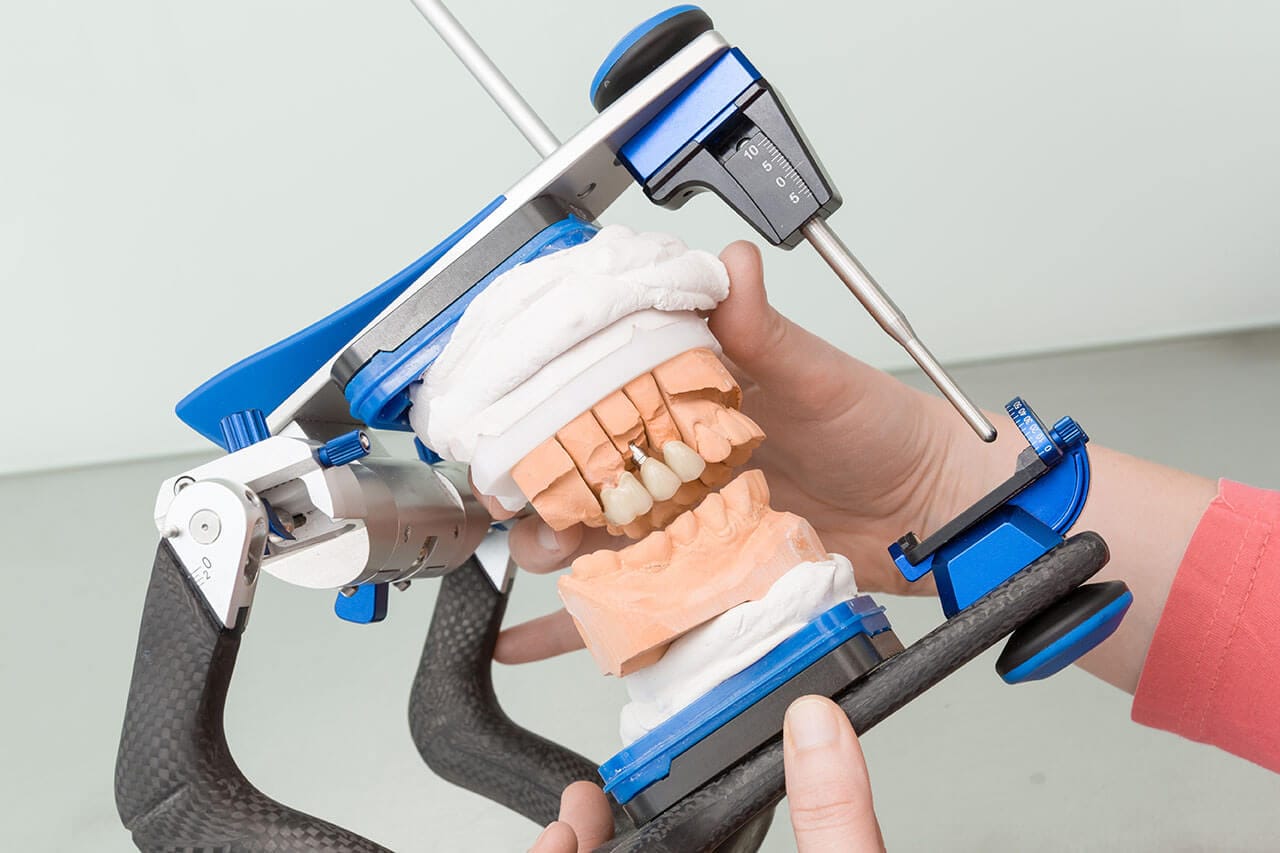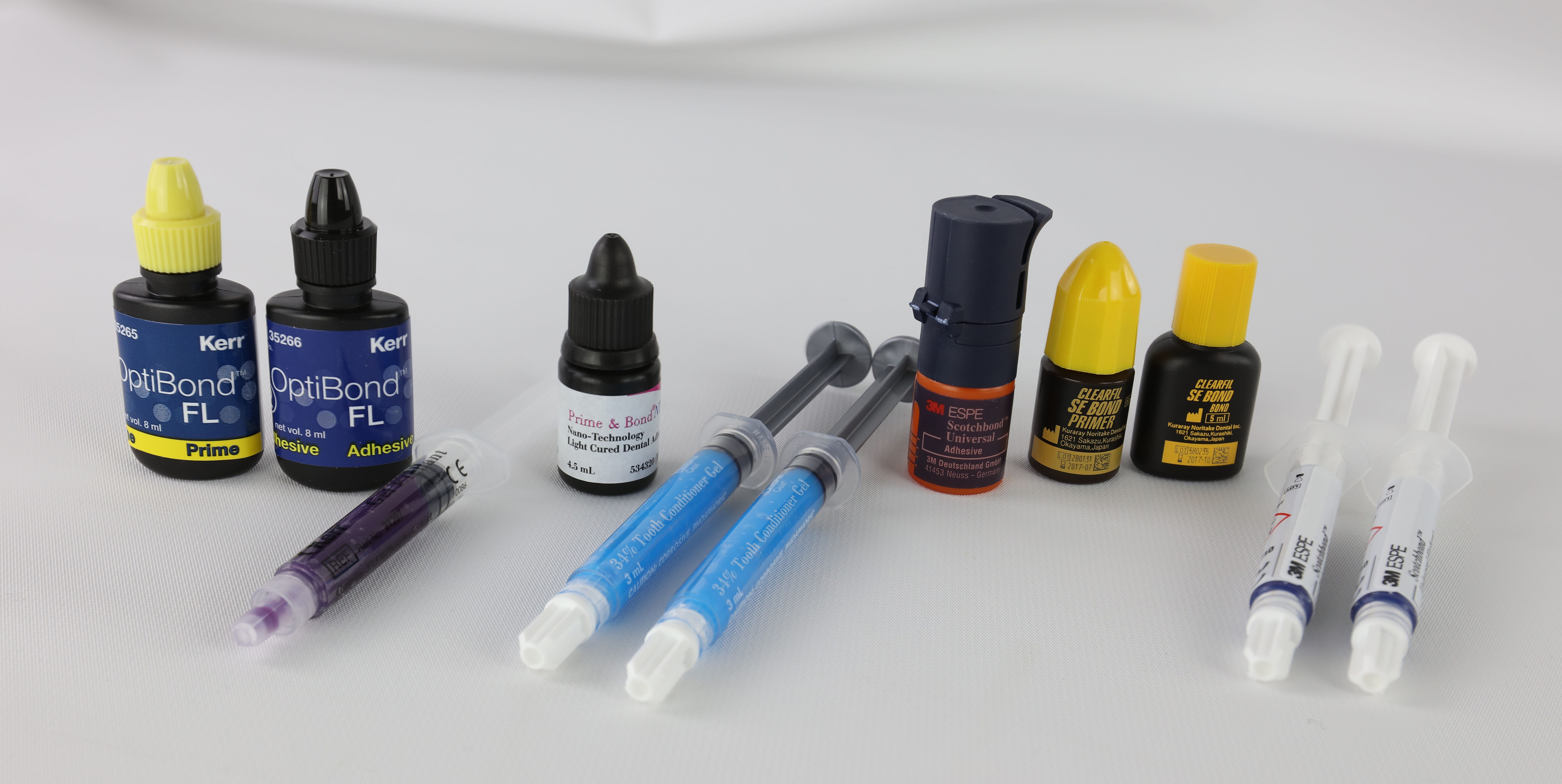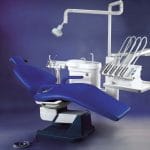In the fast-paced realm of dentistry, dental articulators are essential for crafting precise and effective restorations. If you’re navigating the challenges of selecting the right articulator supplier, you’re not alone—many dental professionals face this critical decision. Did you know that nearly 70% of dentists report that the quality of their tools directly impacts patient outcomes? In this article, we promise to guide you through the landscape of leading articulator suppliers in 2025, highlighting their innovations and how they blend technology with traditional craftsmanship.
You’ll gain insights into the features that set these suppliers apart and discover how to choose the best tools for your practice. Ready to elevate your dental work? Let’s uncover the top players in the market and empower your journey toward dental excellence!
The Evolution of Dental Articulators: From Hinges to High-Tech
The journey of dental articulators reflects the relentless pursuit of precision in dentistry. From simple hinge devices in the early 20th century to today’s sophisticated digital systems, articulators have undergone a remarkable transformation, mirroring the advancements in our understanding of occlusion and jaw biomechanics.
Historical Progression
The evolution of dental articulators can be traced through distinct phases, each marked by significant improvements in design and functionality:
- Early 20th Century: The dawn of articulator technology saw the introduction of simple hinge-based devices. These rudimentary instruments offered limited functionality, providing only a basic simulation of jaw opening and closing movements. While revolutionary for their time, these early articulators were far from the sophisticated instruments we know today.
- Mid-20th Century: As researchers delved deeper into the complexities of occlusion, articulator designs became increasingly sophisticated. This period saw the introduction of adjustable components that allowed for more accurate replication of individual patient characteristics. The concept of centric relation and its importance in prosthetic dentistry began to influence articulator design significantly.
- Late 20th Century: The advent of semi-adjustable and fully adjustable articulators marked a quantum leap in precision. These instruments offered dentists the ability to fine-tune settings such as condylar inclination and Bennett angle. The Denar Mark II Semi-Adjustable Articulator, for instance, became a staple in many dental practices, offering a balance of accuracy and ease of use.
- 21st Century: The digital revolution has ushered in a new era of articulator technology. Integration with CAD/CAM systems and intraoral scanners has transformed the landscape of prosthetic dentistry. Virtual articulators now allow for precise simulation of jaw movements in a digital environment, enhancing treatment planning and restoration design.
Modern Innovations
Today’s cutting-edge articulators seamlessly integrate with digital workflows, offering unprecedented levels of accuracy and efficiency. The Artex CT from Amann Girrbach AG exemplifies this fusion of traditional craftsmanship with digital innovation. This system allows for virtual articulation and seamless data transfer between the physical and digital realms, revolutionizing the way dental professionals approach complex cases.Key features of modern articulators include:
- High-precision adjustability for patient-specific parameters
- Compatibility with CAD/CAM systems for streamlined workflows
- Advanced materials for improved durability and accuracy
- Ergonomic designs for enhanced user experience
Case Study: Digital Articulation in Complex Rehabilitation
A recent full-mouth rehabilitation case demonstrates the power of digitally integrated articulators. The dental team utilized the Artex CT in conjunction with intraoral scanning and CAD/CAM technology. This comprehensive digital workflow allowed for:
- Precise virtual articulation of the patient’s unique occlusal scheme
- Detailed analysis of dynamic occlusion in various mandibular movements
- Efficient design and fabrication of the final prostheses
The result was a final restoration that required minimal chairside adjustments and achieved optimal occlusal harmony. This case underscores the potential of modern articulator technology to enhance treatment outcomes and improve patient satisfaction in complex prosthetic cases.
As we look to the future, the integration of artificial intelligence and machine learning promises to further revolutionize articulator technology. These advancements may lead to real-time adjustments based on patient-specific data, potentially offering even greater precision in dental restorations.
Semi-Adjustable vs. Fully-Adjustable Articulators: Precision in Prosthetic Dentistry
Understanding the nuances between semi-adjustable and fully-adjustable articulators is crucial for dental professionals seeking to optimize their prosthetic outcomes. These sophisticated instruments play a vital role in replicating jaw movements, ensuring the accuracy and functionality of dental restorations. Let’s delve deeper into the characteristics, advantages, and limitations of each type to guide informed decision-making in clinical practice.
Semi-Adjustable Articulators: Balancing Accuracy and Efficiency
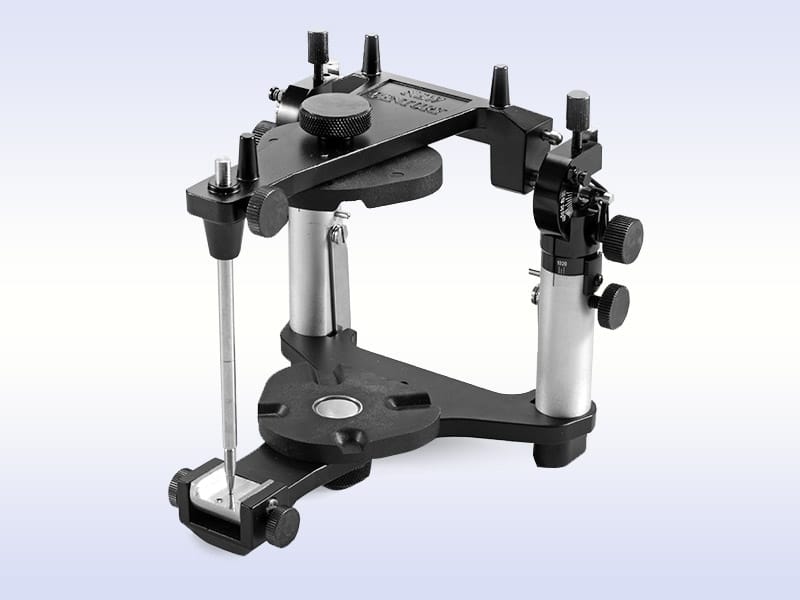
Semi-adjustable articulators, exemplified by models like the Whip Mix Denar Mark II, offer a pragmatic balance between accuracy and practicality, making them suitable for a wide range of routine restorative cases.
Key Features:
- Adjustable condylar inclination
- Limited Bennett angle adjustment
- Fixed intercondylar distance
These features allow for a reasonable approximation of patient-specific jaw movements, providing sufficient accuracy for many common dental procedures.
Advantages:
- Cost-effectiveness: Ideal for general dental practices with diverse case loads
- Versatility: Suitable for single-unit restorations and simple bridges
- User-friendly: Easier to use with reduced setup time, enhancing workflow efficiency
Limitations:
- May not capture all nuances of complex jaw movements
- Less precise for comprehensive full-mouth rehabilitations
According to a 2022 survey by the American Dental Association, 68% of general dental practices primarily use semi-adjustable articulators for their restorative work.
Fully-Adjustable Articulators: Precision Personified
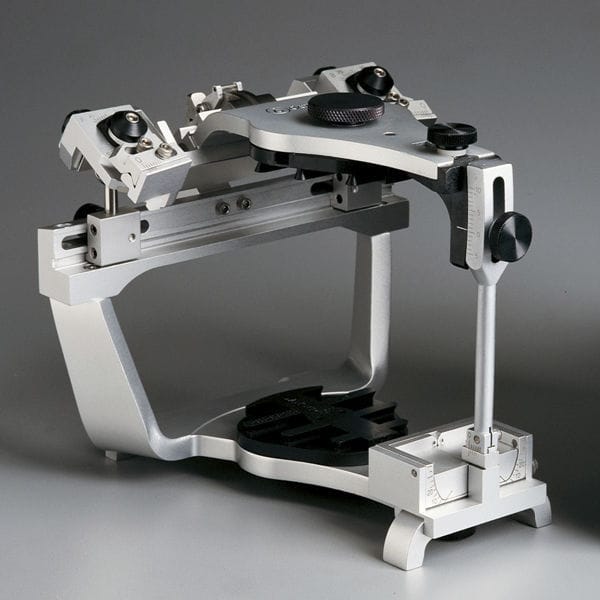
Fully-adjustable articulators, such as the Denar D5A, represent the pinnacle of articulator technology, offering unparalleled customization and accuracy. These sophisticated instruments are indispensable for complex prosthetic cases that demand meticulous attention to detail.
Key Features:
- Adjustable condylar inclination with curved condylar paths
- Variable intercondylar distance
- Adjustable progressive side shift (immediate and progressive Bennett angle)
- Customizable incisal guidance
This comprehensive range of adjustments allows for precise replication of individual patient characteristics, crucial for complex cases.
Advantages:
- Ideal for complex full-mouth rehabilitations
- Capable of replicating intricate jaw movements with high fidelity
- Essential for cases involving temporomandibular joint (TMJ) disorders or severe malocclusions
Limitations:
- Higher initial investment cost
- Steeper learning curve for optimal utilization
- Time-consuming setup and adjustment process
A 2023 study in the Journal of Prosthodontics found that fully-adjustable articulators reduced the need for chairside adjustments by 37% in complex prosthetic cases compared to semi-adjustable models.
Comparative Analysis: Performance in Clinical Scenarios
A landmark 2023 study published in the Journal of Prosthodontics compared the accuracy of semi-adjustable and fully-adjustable articulators in replicating eccentric jaw movements. The research, conducted across 150 patients with varying occlusal complexities, yielded significant insights:
- Routine Cases: Both types performed adequately, with no statistically significant difference in outcomes for single-unit restorations and simple bridges.
- Complex Cases: Fully-adjustable articulators demonstrated superior accuracy in reproducing complex mandibular movements, particularly in patients with atypical occlusal schemes.
- TMJ Disorders: In cases involving TMJ dysfunction, fully-adjustable articulators provided a 28% improvement in replicating patient-specific jaw movements compared to semi-adjustable models.
- Full-Mouth Rehabilitations: Fully-adjustable articulators reduced the need for post-insertion occlusal adjustments by 42% in comprehensive rehabilitation cases.
These findings underscore the importance of selecting the appropriate articulator based on case complexity and individual patient needs.
Top Articulator Suppliers: A Comparative Analysis
In the competitive landscape of dental articulator manufacturing, several companies stand out for their innovation, quality, and comprehensive product offerings.
1. Whip Mix Corporation

Founded in 1919, Whip Mix Corporation has established itself as a pillar of the dental industry.
Key Features:
- Comprehensive range of articulators
- Strong focus on education and customer support
- Integration of traditional craftsmanship with modern technology
Notable Products:
- Denar Mark II Semi-Adjustable Articulator
- Denar D5A Fully Adjustable Articulator
Unique Selling Point:
Whip Mix’s commitment to customization sets it apart, offering a wide range of adjustable parameters for precise replication of individual patient characteristics.
Official Website: Whip Mix Corporation
2. Amann Girrbach AG

This Austrian powerhouse has made significant strides in integrating articulator technology with digital workflows.
Key Features:
- Focus on ergonomic design and user-friendly interfaces
- Seamless integration with CAD/CAM systems
- Commitment to ongoing innovation in digital dentistry
Notable Products:
- Artex CR: Semi-adjustable articulator with high precision
- Artex CP: Fully adjustable model for complex cases
- Artex CT: Cutting-edge digitally integrated articulator
Unique Selling Point:
Amann Girrbach’s Artex CT model stands out for its seamless integration with digital workflows, making it a favorite among tech-savvy dental professionals.
Official Website: Amann Girrbach AG
3. Ivoclar Vivadent AG
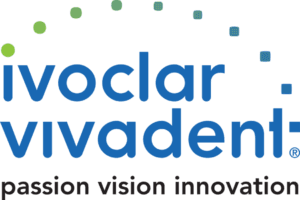
This Swiss multinational offers a comprehensive range of dental products, with articulators designed to integrate seamlessly into their broader ecosystem.
Key Features:
- Focus on system integration and workflow efficiency
- Strong emphasis on material science and compatibility
- Comprehensive training and support programs
Notable Products:
- Stratos 100: Average-value articulator for routine cases
- Stratos 300: Individual articulator for more complex work
Unique Selling Point:
Ivoclar Vivadent’s strength lies in the synergy between their articulators and other dental products, allowing for a streamlined workflow.
Official Website: Ivoclar Vivadent AG
4. KaVo Dental

As a subsidiary of Dentsply Sirona, KaVo Dental leverages global resources to deliver high-quality articulators backed by extensive support networks.
Key Features:
- Emphasis on digital integration and advanced technology
- Strong commitment to customer education and training
- Global support infrastructure
Notable Product:
- PROTARevo Adjustable Articulator: Known for its exceptional accuracy in replicating complex jaw movements
Unique Selling Point:
KaVo’s PROTARevo stands out for its unparalleled accuracy and flexibility in replicating complex occlusal relationships, coupled with comprehensive training programs.
Official Website: KaVo Dental
Key Considerations for Selecting Your Ideal Articulator
Choosing the right articulator is a critical decision that can significantly impact the quality of dental restorations and practice efficiency. As dental technology continues to evolve, understanding the nuances of articulator selection becomes increasingly important for both general practitioners and specialists alike.
1. Assessing Case Complexity and Practice Needs
The foundation of articulator selection lies in a thorough evaluation of your practice’s caseload and anticipated future needs. This assessment should guide your decision-making process, ensuring that the chosen articulator aligns with your clinical requirements.
For General Practices:
Semi-adjustable articulators often suffice for routine restorative work, offering a balance between accuracy and practicality. These articulators, such as the Whip Mix Denar Mark II, provide adequate functionality for single-unit restorations and simple bridges. However, it’s crucial to consider the volume of complex cases you encounter. A 2023 survey by the American Dental Association found that 68% of general practices reported an increase in complex restorative cases over the past five years, highlighting the need for versatile articulator systems.
For Specialty Practices:
Prosthodontists and practices focusing on complex rehabilitations should consider fully adjustable systems. These articulators, like the Denar D5A, offer superior customization options, allowing for precise replication of patient-specific jaw movements. When evaluating articulators for specialty use, consider features such as adjustable condylar inclination, variable intercondylar distance, and customizable incisal guidance.
2. Integration with Digital Workflows
As digital dentistry continues to evolve, the ability of articulators to integrate with CAD/CAM systems and intraoral scanners becomes increasingly important. This integration can significantly enhance workflow efficiency and treatment outcomes.
Key Considerations:
- Compatibility with existing digital systems in your practice
- Ability to transfer articulation data seamlessly between physical and virtual environments
- Future-proofing your investment by choosing systems with ongoing software updates and support
A 2024 study in the Journal of Prosthetic Dentistry found that practices using digitally integrated articulators reported a 37% reduction in chairside adjustment time for complex restorations compared to those using traditional systems.
3. Ergonomics and Ease of Use
The usability of an articulator can significantly impact daily workflow and staff efficiency. Ergonomic design and intuitive operation are crucial factors that contribute to long-term satisfaction with your chosen system.
Factors to Consider:
- Intuitive controls and clear visual indicators for precise adjustments
- Weight and maneuverability to reduce operator fatigue during extended use
- Ease of mounting casts and adjusting settings to streamline workflow
Dr. Sarah Chen, a renowned prosthodontist, emphasizes, “An articulator that’s easy to use not only improves efficiency but also encourages consistent use among team members, leading to better overall outcomes.”
4. Durability and Longevity
Investing in a high-quality articulator should be viewed as a long-term decision. The durability of the system can significantly impact your practice’s bottom line over time.
Key Aspects:
- Material quality and construction robustness to withstand daily use
- Reputation for reliability and minimal maintenance requirements
- Availability of replacement parts and service support to ensure longevity
A 2023 cost analysis published in the Journal of Dental Technology revealed that high-quality articulators, while initially more expensive, resulted in a 22% lower total cost of ownership over a 10-year period compared to budget alternatives.
5. Training and Support
The value of an articulator extends beyond its physical features to include the support ecosystem provided by the manufacturer. Comprehensive training and ongoing support are crucial for maximizing the benefits of your chosen system.
Essential Elements:
- Availability of comprehensive training programs for all skill levels
- Access to ongoing technical support for troubleshooting and optimization
- Resources for continuing education to stay updated on best practices and new techniques
KaVo Dental, for example, offers a comprehensive online learning platform that has been shown to reduce the learning curve for new users by up to 40%, according to internal company data.
Comparative Pricing and Features Table
| Brand | Model | Type | Price Range (USD) | Key Features |
|---|---|---|---|---|
| Whip Mix | Denar Mark II | Semi-Adjustable | $1,500 – $2,000 | Versatile, cost-effective |
| Whip Mix | Denar D5A | Fully Adjustable | $3,000 – $3,500 | High precision, customizable |
| Amann Girrbach | Artex CR | Semi-Adjustable | $2,000 – $2,500 | Ergonomic design |
| Amann Girrbach | Artex CT | Digitally Integrated | $4,000 – $4,500 | Digital workflow integration |
| Ivoclar Vivadent | Stratos 100 | Average-Value | $1,000 – $1,500 | Basic functionality |
| Ivoclar Vivadent | Stratos 300 | Individual | $2,500 – $3,000 | Enhanced customization |
| KaVo | PROTARevo | Fully Adjustable | $3,500 – $4,000 | High accuracy, comprehensive training |
Note: Prices are approximate and may vary based on location and specific configurations.
The Future of Articulator Technology
As we look ahead to 2025 and beyond, several trends are shaping the future of dental articulator technology:
- AI Integration: Artificial intelligence is being incorporated into articulator systems to predict and adjust for patient-specific jaw movements in real-time.
- Virtual Reality Applications: VR technology is being explored for more immersive and accurate virtual articulation experiences.
- Sustainable Materials: Manufacturers are developing eco-friendly articulator components in response to growing environmental concerns.
- Enhanced Connectivity: Future articulators will likely offer improved integration with practice management software and patient records systems.
- 3D Printing Compatibility: As 3D printing becomes more prevalent in dentistry, articulators are being designed to work seamlessly with 3D-printed models and restorations.
Conclusion
Selecting the right dental articulator is a crucial decision that impacts the quality of patient care and practice efficiency. By carefully evaluating the offerings of top articulator suppliers against your specific needs, you can make an informed decision that enhances clinical outcomes and operational efficiency.
Remember to consider factors such as case complexity, digital integration, ergonomics, durability, and support when making your choice. Stay informed about emerging technologies and trends in articulator design to ensure your practice remains at the forefront of dental innovation.
Investing in a high-quality articulator from a reputable supplier is not just a purchase; it’s an investment in precision, efficiency, and unparalleled patient care in your dental practice.
For more information on dental articulators and their applications, visit the American Dental Association or the American College of Prosthodontists websites.
